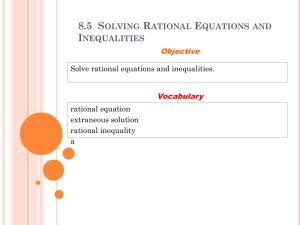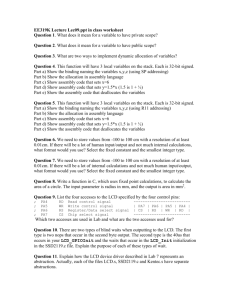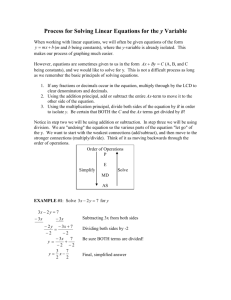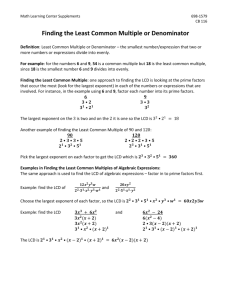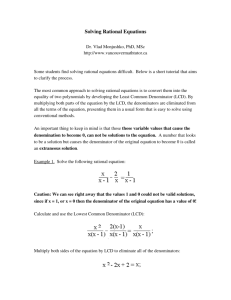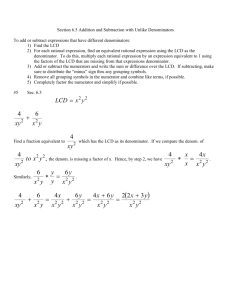Solving Rational Equations
advertisement
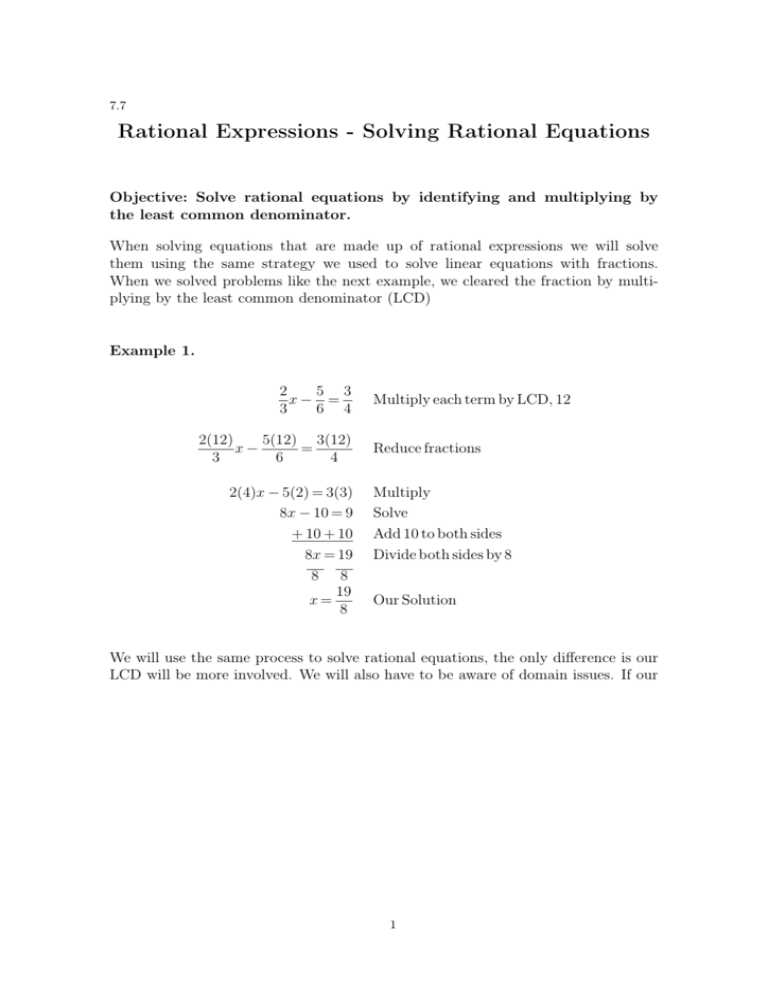
7.7 Rational Expressions - Solving Rational Equations Objective: Solve rational equations by identifying and multiplying by the least common denominator. When solving equations that are made up of rational expressions we will solve them using the same strategy we used to solve linear equations with fractions. When we solved problems like the next example, we cleared the fraction by multiplying by the least common denominator (LCD) Example 1. 5 3 2 x− = 6 4 3 2(12) 5(12) 3(12) x− = 3 6 4 2(4)x − 5(2) = 3(3) 8x − 10 = 9 + 10 + 10 8x = 19 8 8 19 x= 8 Multiply each term by LCD, 12 Reduce fractions Multiply Solve Add 10 to both sides Divide both sides by 8 Our Solution We will use the same process to solve rational equations, the only difference is our LCD will be more involved. We will also have to be aware of domain issues. If our 1 LCD equals zero, the solution is undefined. We will always check our solutions in the LCD as we may have to remove a solution from our solution set. Example 2. 5x + 5 x2 + 3x = x+2 x+2 (5x + 5)(x + 2) x2(x + 2) + 3x(x + 2) = x+2 x+2 5x + 5 + 3x(x + 2) = x2 5x + 5 + 3x2 + 6x = x2 3x2 + 11x + 5 = x2 − x2 − x2 2x2 + 11x + 5 = 0 (2x + 1)(x + 5) = 0 2x + 1 = 0 or x + 5 = 0 −1−1 −5−5 2x = − 1 or x = − 5 2 2 1 x = − or − 5 2 3 1 −5+2=−3 − +2= 2 2 1 x = − or − 5 2 Multiply each term by LCD, (x + 2) Reduce fractions Distribute Combine like terms Make equation equal zero Subtract x2 from both sides Factor Set each factor equal to zero Solve each equation Check solutions, LCD can ′t be zero Neither make LCD zero, both are solutions Our Solution The LCD can be several factors in these problems. As the LCD gets more complex, it is important to remember the process we are using to solve is still the same. Example 3. x 1 5 + = x + 2 x + 1 (x + 1)(x + 2) Multiply terms by LCD, (x + 1)(x + 2) x(x + 1)(x + 2) 1(x + 1)(x + 2) 5(x + 1)(x + 2) + = x+2 x+1 (x + 1)(x + 2) Reduce fractions 2 x(x + 1) + 1(x + 2) = 5 x2 + x + x + 2 = 5 x2 + 2x + 2 = 5 −5−5 x2 + 2x − 3 = 0 (x + 3)(x − 1) = 0 x + 3 = 0 or x − 1 = 0 −3−3 +1+1 x = − 3 or x = 1 ( − 3 + 1)( − 3 + 2) = ( − 2)( − 1) = 2 (1 + 1)(1 + 2) = (2)(3) = 6 x = − 3 or 1 Distribute Combine like terms Make equatino equal zero Subtract 6 from both sides Factor Set each factor equal to zero Solve each equation Check solutions, LCD can ′t be zero Check − 3 in (x + 1)(x + 2), it works Check 1 in (x + 1)(x + 2), it works Our Solution In the previous example the denominators were factored for us. More often we will need to factor before finding the LCD Example 4. x 1 11 − = 2 x−1 x−2 x − 3x + 2 (x − 1)(x − 2) LCD = (x − 1)(x − 2) 11(x − 1)(x − 2) x(x − 1)(x − 2) 1(x − 1)(x − 2) − = x−2 (x − 1)(x − 2) x−1 x(x − 2) − 1(x − 1) = 11 x2 − 2x − x + 1 = 11 x2 − 3x + 1 = 11 − 11 − 11 2 x − 3x − 10 = 0 (x − 5)(x + 2) = 0 x − 5 = 0 or x + 2 = 0 +5+5 −2−2 x = 5 or x = − 2 (5 − 1)(5 − 2) = (4)(3) = 12 ( − 2 − 1)( − 2 − 2) = ( − 3)( − 4) = 12 x = 5 or − 2 3 Factor denominator Identify LCD Multiply each term by LCD, reduce Distribute Combine like terms Make equation equal zero Subtract 11 from both sides Factor Set each factor equal to zero Solve each equation Check answers, LCD can ′t be 0 Check 5 in (x − 1)(x − 2), it works Check − 2 in (x − 1)(x − 2), it works Our Solution World View Note: Maria Agnesi was the first women to publish a math textbook in 1748, it took her over 10 years to write! This textbook covered everything from arithmetic thorugh differential equations and was over 1,000 pages! If we are subtracting a fraction in the problem, it may be easier to avoid a future sign error by first distributing the negative through the numerator. Example 5. x−2 x+2 5 − = x−3 x+2 8 x−2 −x−2 5 + = x+2 8 x−3 Distribute negative through numerator Identify LCD, 8(x − 3)(x + 2), multiply each term (x − 2)8(x − 3)(x + 2) ( − x − 2)8(x − 3)(x + 2) 5 · 8(x − 3)(x + 2) + = Reduce x+2 8 x−3 FOIL Distribute Combine like terms Make equation equal zero Subtract 8x and 16 Factor Set each factor equal to zero Solve each equation 8(x − 2)(x + 2) + 8( − x − 2)(x − 3) = 5(x − 3)(x + 2) 2 2 2 8(x − 4) + 8( − x + x + 6) = 5(x − x − 6) 8x2 − 32 − 8x2 + 8x + 48 = 5x2 − 5x − 30 8x + 16 = 5x2 − 5x − 30 − 8x − 16 − 8x − 16 2 0 = 5x − 13x − 46 0 = (5x − 23)(x + 2) 5x − 23 = 0 or x + 2 = 0 + 23 + 23 −2−2 5x = 23 or x = − 2 5 5 23 x= or − 2 5 8 23 −3 5 23 8 +2 =8 5 5 33 5 = Check solutions, LCD can ′t be 0 23 in 8(x − 3)(x + 2), it works 5 Check − 2 in 8(x − 3)(x + 2), can ′t be 0! 2112 25 Check 8( − 2 − 3)( − 2 + 2) = 8( − 5)(0) = 0 23 x= 5 Our Solution In the previous example, one of the solutions we found made the LCD zero. When this happens we ignore this result and only use the results that make the rational expressions defined. Beginning and Intermediate Algebra by Tyler Wallace is licensed under a Creative Commons Attribution 3.0 Unported License. (http://creativecommons.org/licenses/by/3.0/) 4 7.7 Practice - Solving Rational Equations Solve the following equations for the given variable: 1 1 4 1) 3x − 2 − x = 0 2) x + 1 = x + 1 20 5x 4) x2 + 6 x−1 6 2x 6) x−4 x−1 8) 6x + 5 2x2 − 2x 3) x + x − 4 = x − 4 − 2 5) x + x − 3 = x − 3 7) 2x 3x − 4 9) 3m 2m − 5 4x + 5 3 = 6x − 1 − 3x − 4 7 3 7 3−x + 2 = 4−x 14) 2 3−x − 8−x = 1 3x + 8 16) x+2 3x − 1 5 18) x−1 x−3 20) 3x − 5 5x − 5 22) x−1 x−2 + 2x + 1 = 2x2 − 3x − 2 24) x x+3 − x − 2 = x2 + x − 6 26) 2x x+2 + x − 4 = x2 − 2x − 8 28) x x+1 − x + 3 = x2 + 4x + 3 30) x−3 x+6 + x − 3 = x2 + 3x − 18 32) x+3 x−2 + x + 1 = x2 − x − 2 34) 3x − 1 x+6 = 3−x 13) 7 y −3 − 2 = y−4 15) 1 x+2 − 2 − x = x2 − 4 17) x+1 x−1 − x+1 = 6 19) 3 2x + 1 21) x−2 x+3 − x − 2 = x2 + x − 6 23) 3 x+2 + x + 5 = 6x + 24 25) x x−1 − x + 1 = x2 − 1 27) 2x x+1 − x + 5 = x2 + 6x + 5 29) x−5 x−9 + x − 3 = x2 − 12x + 27 31) x−3 x−6 + x + 3 = x2 − 3x − 18 33) 4x + 1 x+3 y−2 8x2 2x + 1 + 1 − 2x = 1 − 4x2 − 1 1 1 x−1 5x + 20 2 4x2 3 − 8x2 x+3 − 4x2 x+5 − 2x2 + 5x − 3 x−1 3x 12) 12 4−x 1−x x−1 2 − 1 − x2 = x2 − 1 4x 2x − 6 11) 1 12 = 3−x + 1 10) − 3m + 1 = 2 1 x−2 + x − 1 = 2x 8x2 = x2 + 2x − 3 4 1 − 5x − 15 = 2 1 3 6 1 3x − 3 − x = 3x2 − x x+2 3 + x+3 = 4 5x − 1 x−4 + 7x − 7 − 1 − x = 2 x+4 1 4 − 5x2 2 3x 3 − 2x2 x−2 x2 x−2 9x2 − 2x − 3 x−3 − 3x2 = x2 + 3x − 18 Beginning and Intermediate Algebra by Tyler Wallace is licensed under a Creative Commons Attribution 3.0 Unported License. (http://creativecommons.org/licenses/by/3.0/) 5 7.7 Answers - Solving Rational Equations 1 2 16 ,5 3 1) − 2 , 3 13) 2) − 3, 1 14) 2, 13 3) 3 15) − 8 4) − 1, 4 16) 2 5) 2 17) − 5 , 5 1 3 6) 7) − 1 8) − 10) − 1 2 27) 3 10 18) − 5 , 1 9 29) − 3 3 2 30) − 1 2 31) 21) 0, 5 7 15 26) 28) 1 20) 10 9) − 5 2 3 1 19) 1 3 25) 32) 1 5 22) − 2, 3 11) − 5, 0 23) 4, 7 12) 5, 10 24) − 1 13 4 33) − 10 34) 7 4 Beginning and Intermediate Algebra by Tyler Wallace is licensed under a Creative Commons Attribution 3.0 Unported License. (http://creativecommons.org/licenses/by/3.0/) 6


